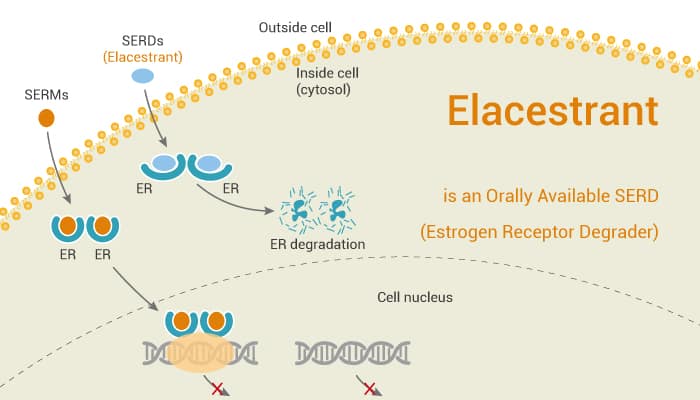Estrogen receptor (ER) is a ligand-induced intracellular transcription factor that mediates the biological effects of estrogen at the level of most gene regulation. The biological effect of estrogen is mediated by ER, which is a member of nuclear receptor family. Specifically, these receptors act as ligand-activated transcription factors. There are two kinds of ER: nuclear ERα and ERβ. Besides, ER is in perimembrane, mitochondria, and nucleus of the estrogen-dependent target tissue. Moreover, it has similar but different regulatory potential. Different intracellular localization of ER leads to dynamic integration and fine-tuning of E2 signaling cascade, which coordinates cell growth, differentiation, and death.
Furthermore, ER plays a role by regulating the transcription process. The classical mechanism of ER involves the binding of estrogen to receptors in the nucleus. The receptor then dimerizes and binds to a specific response element called estrogen response element (ERE) located in the promoter of the target gene. Meanwhile, membrane-associated ER mediates the non-genomic effects of estrogen, which can lead to changes in protein function and regulation of gene expression in the cytoplasm. Nonetheless, estrogen and the ER are prominent drivers of breast tumorigenesis and breast cancer progression. Here, we will introduce an orally available selective estrogen receptor degrader (SERD), Elacestrant.

Elacestrant is an Orally Available SERD (Estrogen Receptor Degrader).
First of all, Elacestrant is a selective SERD with IC50s of 48 and 870 nM for ERα and ERβ, respectively. Elacestrant selectively binds and degrades ER. Importantly, Elacestrant is an effective antagonist of ER-positive breast cancer cell proliferation. Particularly, Elacestrant has a high affinity for ERα, resulting in rapid and complete degradation of the ER.
In the second place, the Elacestrant dose-dependently inhibits the ERα expression, with an EC50 of 0.6 nM. Elacestrant. In the presence of 10 pM E2, Elacestrant resulted in a dose-dependent decrease in cell proliferation with an IC50 value of 4.2 nM. Obviously, Elacestrant is an effective breast cancer cell antagonist. Interestingly, Elacestrant can inhibit the proliferation of basal and E2 stimulated MCF-7 cells.
Last but not the least, Elacestrant produces a profound inhibition with tumor growth in MCF-7 xenograft models. By the way, Elacestrant causes longer survived than those treated with either control. Elacestrant preserves bone loss induced by ovariectomy and prevents the uterine effect of E2. In particular, Elacestrant is an agonist in bone, but an antagonist in the breast and uterus. In xenograft model, Elacestrant showed dose-dependent antitumor activity and induced more significant antitumor effect without significant side effects or toxicity.
All in all, Elacestrant is an orally available selective estrogen receptor degrader (SERD).
References:
Garner F, et al. Anticancer Drugs. 2015 Oct;26(9):948-56.